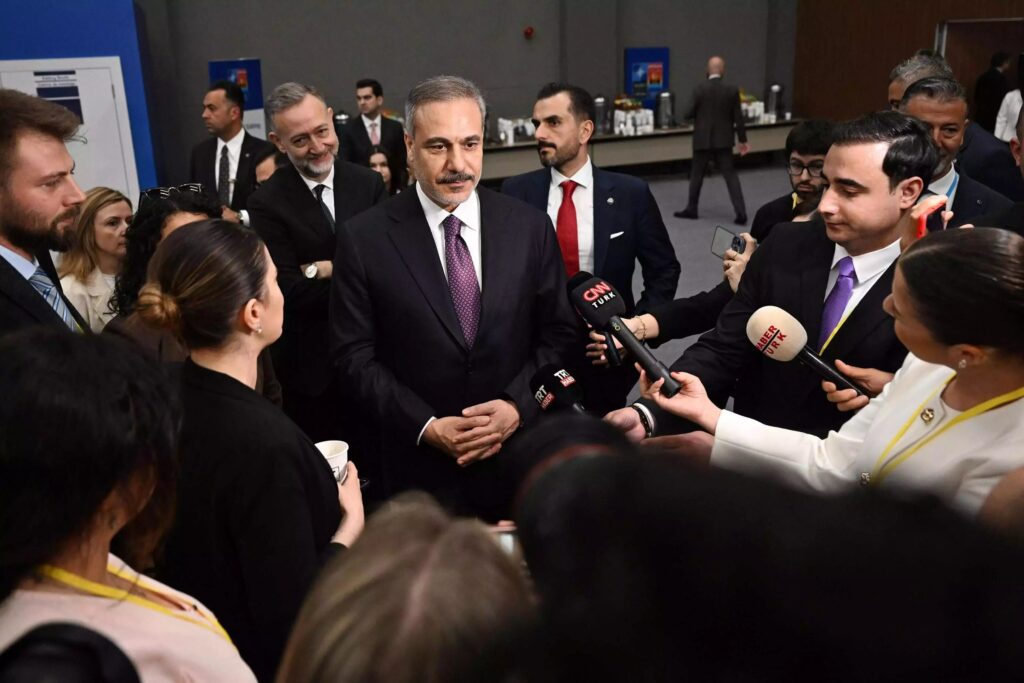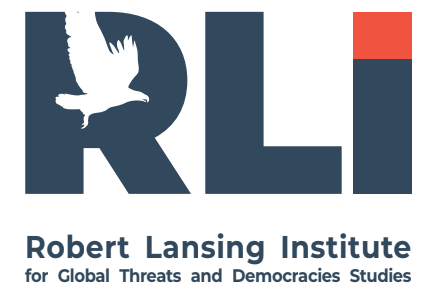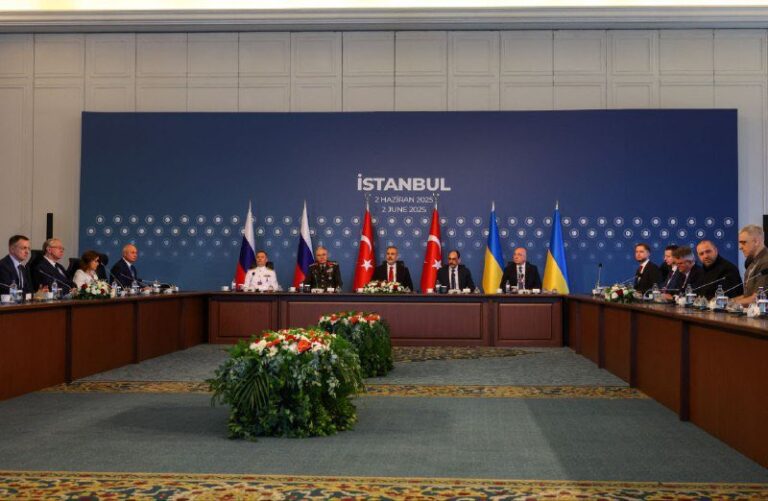The Istanbul negotiations between Ukraine and Russia, held in March 2022, initially raised cautious optimism about the possibility of a diplomatic resolution to the war. However, they ultimately failed to produce lasting results. This failure was not due to a lack of Ukrainian willingness to engage, but rather to Moscow’s systematic strategy to manipulate, stall, and ultimately undermine the process.

More on this story: Beyond Istanbul: Strategic Steps for the Coalition if Putin Refuses Engagement

2. Background: The Istanbul Talks and Their Framework
The negotiations in Istanbul were part of a broader series of peace efforts following Russia’s full-scale invasion of Ukraine in February 2022. At the time, Ukrainian forces had successfully repelled Russian advances on Kyiv, creating a window for talks. The Ukrainian delegation offered a framework of neutrality and security guarantees in exchange for the withdrawal of Russian forces and restoration of territorial integrity.
Despite some signs of convergence, such as Moscow’s formal acknowledgment of Ukraine’s willingness to remain non-aligned, the talks stalled. Soon after, Russia intensified its military operations in the Donbas and launched further assaults on civilian infrastructure.
3. Russia’s Strategy: Negotiating in Bad Faith
Russia entered the negotiations not to reach a settlement but to buy time, regroup militarily, and test Western unity. Key elements of this strategy include:
- Deliberate delay tactics: Russian negotiators often shifted demands and avoided committing to verifiable agreements, making meaningful progress impossible.
- Exploiting the talks for propaganda: Moscow framed its participation as evidence of good faith while continuing military aggression.
- Testing Ukrainian resolve: Russia used the talks to pressure Ukraine into concessions under the threat of escalation, aiming to erode morale and international support for Kyiv.
The Kremlin’s core objective remained unchanged: to subjugate Ukraine and ensure it remains within Russia’s sphere of influence. A genuine peace that respected Ukrainian sovereignty would contradict Putin’s imperial ambitions.
4. Why Russia Undermines Peace Initiatives
The Kremlin undermines peace negotiations for several reasons:
- Territorial ambitions: Russia seeks to retain control over occupied territories, especially Crimea and parts of eastern Ukraine, as strategic and symbolic assets.
- Domestic narrative: A negotiated settlement would contradict the narrative of “denazification” and “demilitarization,” central to justifying the war to the Russian public.
- Geopolitical leverage: Russia believes it can outlast Western resolve and prefers to maintain a low-intensity conflict to destabilize Ukraine and Europe over the long term.
- Avoiding accountability: A peace deal would inevitably involve international oversight and could pave the way for war crime investigations, something the Kremlin seeks to avoid.
5. The Role of Sanctions and Their Potential Impact
Economic sanctions have damaged the Russian economy, but their political effectiveness is mixed:
- Limited short-term impact on Kremlin policy: Sanctions have not yet forced a change in strategic direction. Russia has adapted by deepening ties with China, Iran, and others.
- Potential medium-term pressure: Continued sanctions could eventually degrade Russia’s military production capabilities, erode elite loyalty, and reduce its geopolitical flexibility.
- Sanctions targeting enablers of war: New sanctions focused on financial institutions, dual-use technologies, and third-party enablers (e.g., in Central Asia or the Caucasus) may increase costs for Russia.
- Crucial role of enforcement and unity: Sanctions are most effective when applied in a coordinated, sustained manner, with minimal loopholes.
Ultimately, while sanctions are not a silver bullet, they remain a key tool to constrain Russia’s capacity to sustain the war and pressure it back to the negotiating table—this time under different terms.
6. What Can Be Done: Strategic Recommendations
- Shift focus to military and economic pressure: Since Moscow is not currently negotiating in good faith, the West and Ukraine should prioritize battlefield leverage and economic attrition.
- Support Ukrainian resilience: Continued arms deliveries, economic assistance, and long-term security guarantees are essential to resist Russian pressure and deter future aggression.
- Expose Russian disinformation: Countering the Kremlin’s global propaganda about its commitment to peace is crucial to maintaining international support for Ukraine.
- Prepare for future negotiations: While diplomacy remains essential, future talks must be conditioned on verifiable Russian concessions and stronger international mediation frameworks.
- Consider hybrid deterrence: Cyber, legal, and financial tools should complement military deterrence to constrain Russia’s aggressive behavior.
7. Comparative Cases
Russia’s behavior in the Istanbul negotiations is not unique. Similar patterns are evident in:
- The 2014–2015 Minsk Agreements: Used by Russia to legitimize territorial gains while continuing hybrid warfare.
- Syria peace talks: Russia consistently backed Assad militarily while feigning support for UN-mediated peace processes.
- Georgia (2008): Russia used a brief ceasefire to solidify control over South Ossetia and Abkhazia.
Each case demonstrates Moscow’s preference for negotiation as warfare by other means—tools for achieving strategic goals, not peace.
The Istanbul negotiations failed because Russia never intended for them to succeed. For the Kremlin, talks are tactical pauses, not paths to peace. This behavior reflects a broader pattern of strategic deception and refusal to recognize neighboring countries as truly sovereign. The international community must draw the right conclusions: only sustained pressure—military, economic, and political—can bring about a meaningful diplomatic opening. Sanctions are part of that equation, but they must be part of a comprehensive strategy that understands the true nature of the Kremlin’s war.
The Kremlin does not genuinely respect the White House in strategic terms. Instead, it views the United States as both its main geopolitical rival and the primary obstacle to Russia’s ambitions for global influence. From Moscow’s perspective, undermining U.S. authority and credibility—especially in the realm of international security—is central to its foreign policy.
1. The Kremlin’s Strategic Goal: Undermine U.S. Global Leadership
Vladimir Putin and his inner circle do not seek cooperation with Washington unless it benefits Moscow directly. Their priority is to challenge and discredit U.S. influence, particularly by:
- Exposing perceived hypocrisy in American foreign policy (e.g., Iraq, Libya).
- Framing Washington as weak and in decline, unable to enforce its red lines or defend its allies.
- Supporting alternative power centers (e.g., China, Iran, BRICS) that challenge the U.S.-led global order.
2. Discrediting Washington on the Global Stage
Russia constantly seeks to demonstrate that the U.S.:
- Cannot enforce peace, as seen in Ukraine, Syria, and Gaza.
- Loses influence over its allies, especially in Europe and the Global South.
- Is internally divided, especially on foreign policy continuity (exploiting divisions between administrations like Biden vs. Trump).
Kremlin-backed media and diplomats amplify every U.S. failure—be it Afghanistan’s withdrawal or difficulties in Ukraine—as “proof” that the U.S. is no longer a reliable security actor.
3. Russia’s Tactic: Strategic Mockery + Engagement When Useful
While Moscow may sometimes engage diplomatically with the U.S., it does so only tactically:
- To ease sanctions,
- To gain time militarily,
- Or to project an image of responsibility.
But even during talks (like START treaties or Syria deconfliction lines), Russia often:
- Violates agreements behind the scenes,
- Uses negotiations to gather intelligence, and
- Leverages talks to divide the West (e.g., France or Germany vs. U.S.).
4. Ultimate Objective: Multipolar World Without U.S. Dominance
Putin envisions a world where the U.S. no longer sets the global rules. His policy is to accelerate U.S. decline, especially by:
- Fueling chaos (supporting coups, extremist actors),
- Backstopping rogue states (Iran, North Korea),
- And challenging U.S. influence in key regions like Africa, Latin America, and the Middle East.
The Kremlin does not respect the White House in the traditional diplomatic sense. It sees Washington as a declining hegemon whose global leadership must be discredited, bypassed, or broken. Any cooperation is tactical and transactional. The Kremlin’s strategic narrative hinges on showing that the U.S. can no longer shape global security outcomes, and that Russia (often with China) is a rising alternative.
In the current conditions—where the Kremlin does not respect the United States and is actively working to discredit it—the U.S. cannot “force” Russia to peace in the traditional sense. However, the U.S. can shape the environment in such a way that continuing the war becomes too costly and strategically unsustainable for Russia. Forcing peace in this context means altering Russia’s cost-benefit calculation, not convincing the Kremlin morally or diplomatically.

Why the U.S. Cannot Simply Force Russia to Peace
- Russia is not acting rationally by Western standards
Putin has tied his regime’s survival to the war. Ending it now—especially without a visible “victory”—would damage his image and potentially destabilize his power. - Peace is not the Kremlin’s goal
Moscow views “peace” talks as a means to:- Freeze the front lines,
- Regroup,
- Divide the West,
- Buy time for rearmament.
- U.S. pressure alone is not enough
The Kremlin sees Washington as weak or distracted (due to internal politics or international overstretch) and believes it can wait out U.S. resolve, especially if Trump or an isolationist takes power in 2025.
What the U.S. Can Do to Alter Russia’s Calculations
1. Escalate the Costs of War
- More advanced weapons for Ukraine (ATACMS, F-16s, etc.)
- Allow Ukraine to strike targets inside Russia’s territory
- Help Ukraine threaten Crimea, which is a red line for the Kremlin
2. Target Russian Assets and Power Centers
- Stricter secondary sanctions on Chinese and other foreign entities helping Russia
- Pressure the energy sector harder (oil sanctions enforcement, LNG constraints)
- Sanction Russian elites’ families, tech imports, and shadow networks
3. Strengthen the Global Narrative
- Lead a campaign to portray Russia as a rogue nuclear blackmailer
- Mobilize the Global South diplomatically—not just the EU and NATO
- Expose Russian war crimes and use international tribunals to isolate the regime
4. Build and Demonstrate Long-Term Western Resolve
- Lock in multi-year aid packages for Ukraine regardless of U.S. elections
- Expand NATO defense production and energy independence
- Support democratic resilience in neighboring states (Georgia, Moldova, Armenia)
Could the U.S. eventually force peace?
Only indirectly—by making it strategically impossible for Russia to continue the war without risking regime collapse or unacceptable military defeat. This requires:
- Consistency (not wavering after elections),
- Unity with allies,
- And a clear narrative that peace without justice and deterrence will only invite more wars.




